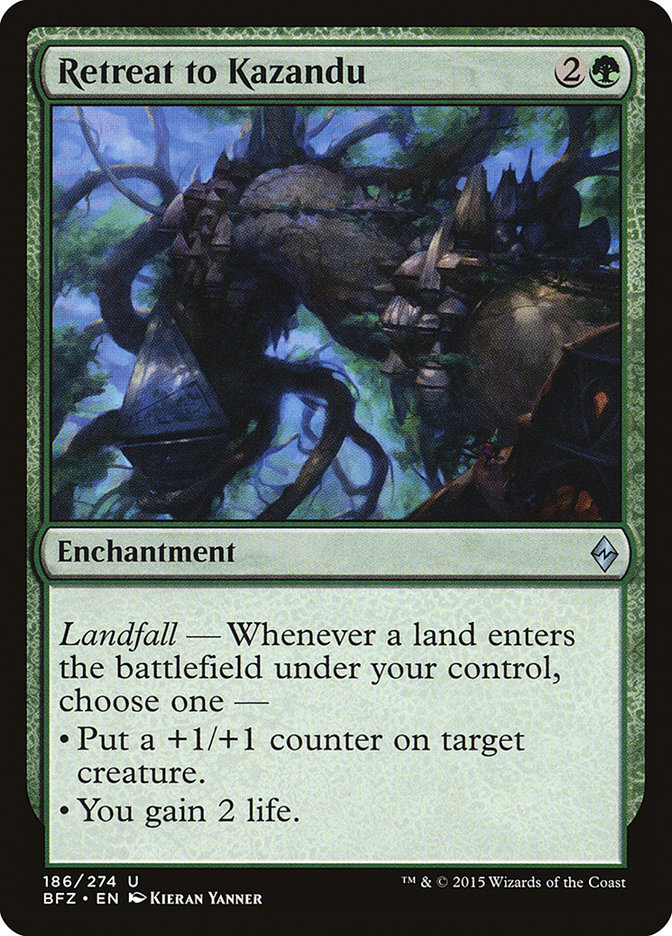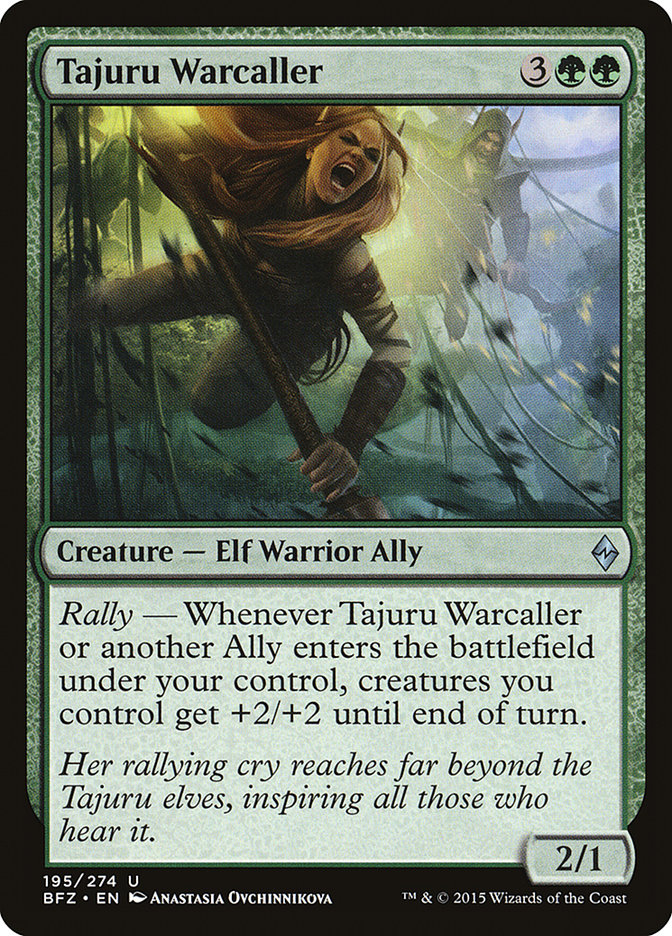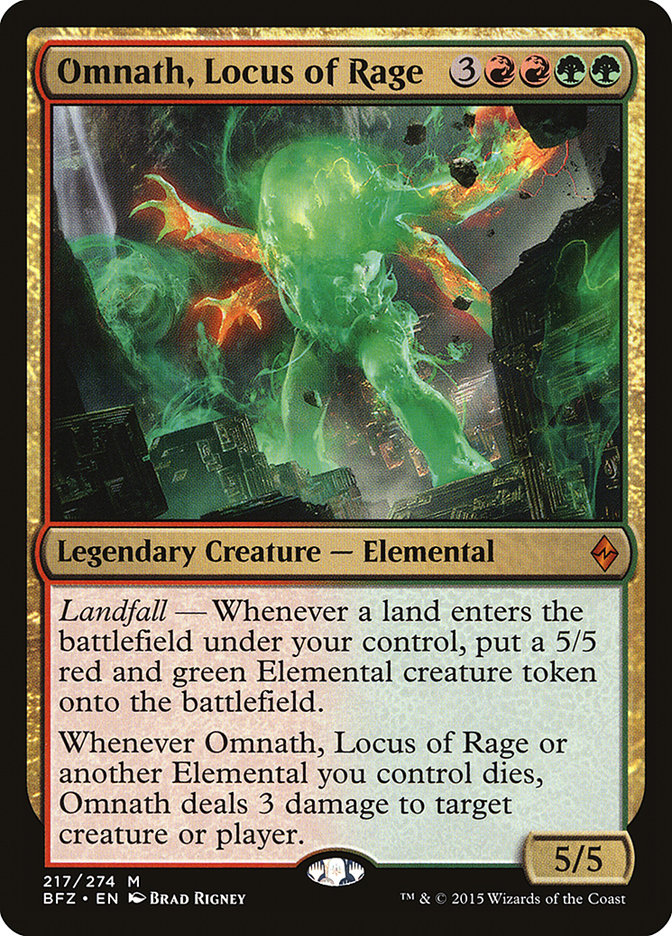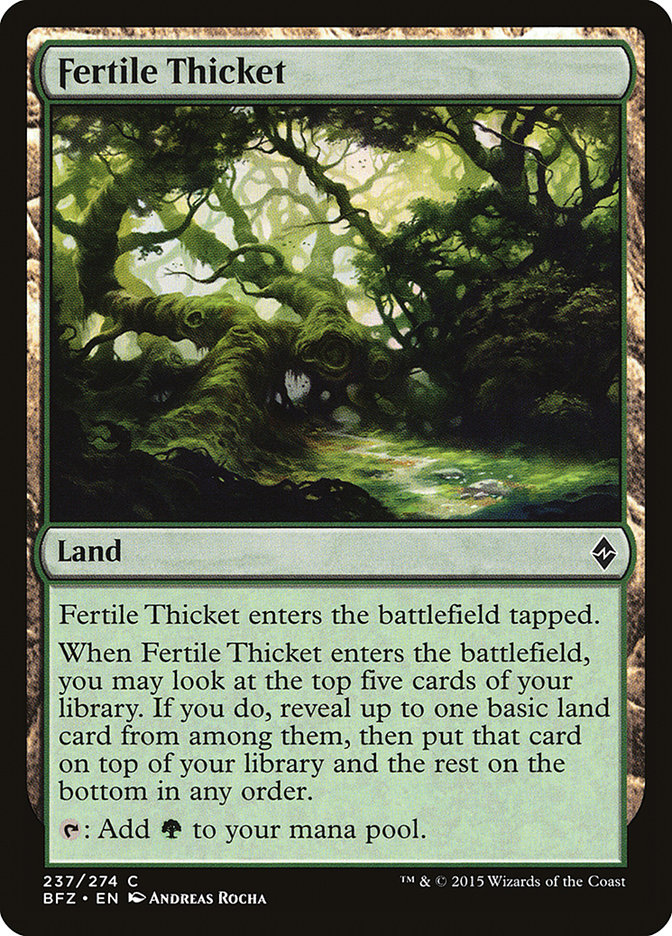It’s come to my attention people are still drafting green in BFZ. I
intend to do a kickstarter with all proceeds going to raise awareness.
— Owen Turtenwald (@OwenTweetenwald) November 6, 2015
Notice those retweets and favorites. Yes, that is Mike Sigrist and Pascal Maynard agreeing, which in turn means three major teams all agreed on Battle for Zendikar being a four-color format.
The data even seems to support this.
Green was the least likely color to 3-0 a draft at the Pro Tour by enough that it is clearly a tier down in success rate.
Of course, the last time Zendikar rolled around, everyone said the exact same thing about green. It was too clunky, didn’t have removal, etc etc. But by
the end of that format, green was by far my favorite color, had the two best commons in the set that weren’t comically overpowered removal, and my plan for
an entire Pro Tour was to force eighteen Forests (or seventeen and a Khalni Garden).
Are we actually playing a four-color format, or is there some way to make the supposedly unplayable green cards work?
Why Green is “Bad”
My team had the following as the top commons in the format.
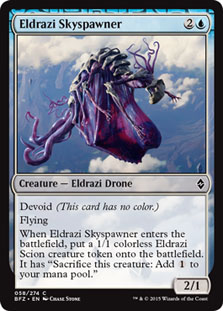
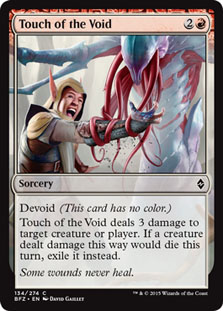
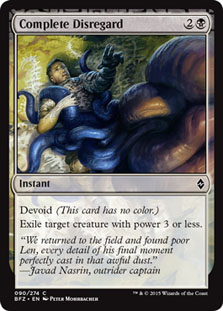
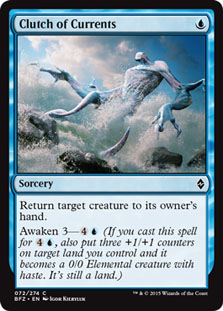

None of these are green.
Then you have another tier of very strong enablers such as Nettle Drone and Mist Intruder, or just tier two removal like Outnumber.
The best green common is Eyeless Watcher, which is in the middle of this second tier. The next best green common is… Snapping Gnarlid? Which is mostly
just a fine creature that gets brickwalled fairly quickly. Past that, you have a lot of cards that are just okay. Lifespring Druid is fine but a bit clunky
and low impact past turn 3. Tajuru Beastmaster is powerful, but still a six-drop.
This should be disconcerting. Back to my original Zendikar example: Hideous End, Burst Lightning, Disfigure, and Journey to Nowhere were
legitimately the best commons, but Timbermaw Larva and Grazing Gladehart were both capable of dominating games. Now compare four mana 6/6 or larger and
Grey Ogre that gains ten life to these cards. Snapping Gnarlid is a good rate, but still just a 3/3 in the end. Eyeless Watcher is often just Captain’s
Call, a mediocre white common from Magic 2013. Tajuru Beastmaster is Craw Wurm. Lifespring Druid is a three-mana ramp spell on a subpar body.
There isn’t anything that really stands out as a card that can just win you the game.
But green never has the Doom Blades, the Topan Freeblades, or the Fiery Impulses unless something messed up happens and it gets Sprout Swarm or Wild
Mongrel. Green historically makes up for it by having a stack of very solid commons.
In Battle for Zendikar, you have a bunch of cards that just don’t live up to expectations. Broodhunter Wurm is borderline unplayable despite Order
of Sacred Bell and Summit Prowler usually being okay because the format is more about building a cohesive shell than per-card power. Same with Giant
Mantis. Unnatural Aggression is bad removal because creature sizing scales so drastically in the format. Often the thing you want to kill is a paygrade
above what you have on the battlefield, instead of the usual setup where green creatures are a touch bigger and are great at punching down with fight
spells. Natural Connection wants to ramp big, but in practice, the fact that it is only one land for one card means you are typically paying for something
that could be free if it was just a basic land.
Then you have a bunch of cards that feel like they should do something but don’t. Earthen Arms is replacement level or below even in the all two-drops
landfall aggressive deck where it makes a 5/4 trample attacker on turn 4. Swell of Growth is mediocre pump that has a bonus that is more of a payday loan
where you get big now in exchange for burnt out landfall dorks the next turn. Seek the Horizons is technically playable as much as any other two mana do
nothing ever is, so it’s somewhere between replacement level and clunky.
What Doesn’t Work
More so than any other color combo, you won’t get away with a pile of cards that are good here because green just doesn’t have purely good cards. Note that
I didn’t say “green just doesn’t have good cards,” which is very different. The green cards build to very specific shells and outcomes that can be hard to
balance. Every white deck wants Sheer Drop, every black deck wants Complete Disregard, not every green deck wants Eyeless Watcher or Snapping Gnarlid.
Green as a full core doesn’t work either. For the most part, the high end power level is going to come from your other colors while green ties it all
together. Odds are if you are looking at playing ten green sources, something went wrong (with the notable exception being made for “I’m concerned about
casting both of these Plated Crushers.”)
Higher Rarity Traps
Similar to the commons, there are a number of uncommon and rare green cards that are significantly worse than their first read makes them seem. People move
into the color for these cards and are disappointed when they don’t meet expectations.
One that surprised me was Retreat to Kazandu. The card reads like Grazing Gladehart, but plays like a straight up brick. Turns out not having power and
toughness kinda sucks. The same generally applies to the other Retreats to the point where the only one I really like playing is the unbeatable one,
Retreat to Emeria.
The other big one is Oran-Rief Hydra. This kind of card would be amazing in most other Limited formats, but there’s so many other big idiots in this one
that it is replacement level at best. Imagine the heads up fight: You need multiple landfall triggers just to fight heads up against Ruin Processor, a
common that costs one more mana. The only time this card has actually impressed me on the battlefield, it was immediately followed up by a Nissa’s Renewal
or Blighted Woodland.
I personally haven’t had experiences with the card, but I’ve been told that Kiora, Master of the Depths is similarly disappointing. The format is not very
card advantage-based, so most of the time Kiora is an awkward planeswalker that can’t protect itself. You have to be ahead on the battlefield to cast the
card as more than a Divination. There are going to be decks and times it is good, and the card is at worst solid, but it’s not the first pick slam that Ob
Nixilis Reignited or Gideon, Ally of Zendikar are.
Things That Do Work
G/R Landfall is a real archetype. Grove Rambler is exceptional, Valakut Predator is solid, and Territorial Baloth, Snapping Gnarlid, and Makindi
Sliderunner are fine. If you get 3-4 copies of the first two cards and reasonable spells, your deck will be reasonable, but the key to a great deck is in
the landfall enabling lands. Evolving Wilds and Blighted Woodland are nearly unpassable as the second landfall trigger pushes your creatures to ludicrous
size. Think of all the upside: When you open a Misty Rainforest or Scalding Tarn, it’s legitimately the best card for your deck if you are drafting
landfall! Your deck can also afford to play extra land if you are dedicated to the archetype, so high end mana sinks like Valakut Invoker are also great.
This is also a very good deck for Unnatural Aggression, as your creatures do actually fight upwards if you can landfall twice in a turn.
Converge Green is a deck, but it’s more an extension of the U/W Awaken deck than anything. Make some mana, Sheer Drop your thing, Coastal Discovery, draw
Halimar Tidecaller, win the game with five cards in hand. Typically this deck ends up being base green, secondary white, splash blue, since the blue cards
honestly kinda suck at playing control and you just want the awaken spells that are answers and random bombs.
The reason to be green and three colors instead of just two is that it’s easier to pick up the defensive green cards than the correct white and blue
equivalents, and the green cards are honestly a little better at filling in the middle quality slots. Specifically, Giant Mantis lines up against Cloud
Manta and Ghostly Sentinel better than Courier Griffin and Tajuru Stalwart. It’s a great way to brick wall the ground early. Lifespring Druid also fits the
plan of make a bunch of mana very nicely and is definitely a better three-drop than Shadow Glider here. Skyrider Elf is a pretty huge payoff that basically
no one else should be touching. On the flip side, the green two-drops are super replaceable here, and most of the time, Fortified Rampart is just better
than Oran-Rief Invoker or Snapping Gnarlid. The dreamboat card to have in this archetype is Nissa’s Renewal as you want the fixing, the million mana it
makes, and the life.
Note that if the removal is flowing in other colors, you don’t have to be G/W/X here. Red is also a reasonable base due to Stonefury being a powerful kill
spell that comes late because it is a bit inefficient. It’s just that white has the best removal at common, and often that’s exactly what you are looking
for.
Tajuru Warcaller and Tajuru Beastmaster make up the last real green deck, which is basically just go wide and Overrun. This deck is usually base G/W Allies
with a splash. Again Tajuru Stalwart plays a big role as a three-color payoff and an Ally. The splash is either heavy into black for Kalastria Healers and
some of the other B/W Allies-Lifegain shell, or into red because you are lucky enough to get Resolute Blademaster. The two cards that this deck gets to
utilize that are cool late pickups are Unified Front and Cliffside Lookout. Grovetender Druids is also great, but I’m unsure that’s a late pickup because
my base impression is that people overrate the card.
There is also a G/U base version of this deck that Olivier Ruel crushed me with in the second draft of Pro Tour Battle for Zendikar, but that deck involves
getting multiple Eldrazi Skyspawners and some super high end payoff for your Spawn tokens when you don’t draw the Overrun, like Ulamog or Void Winnower.
It’s doable, but it requires large numbers of specific effects to pull off.
What Cards Make Me Play Green
I’m willing to strongly lean towards green after an obvious bomb first pick.
There’s another class of cards a bit below that I’m fine-to-happy first picking, but am willing to abandon a bit easier as they aren’t as high payoff. If
one of these cards is passed to me in the second-to-fourth pick range, that’s reason to move in. These range in power level, so note that while Woodland
Wanderer is a great first pick, I’m not nearly as excited to take Blighted Woodland.
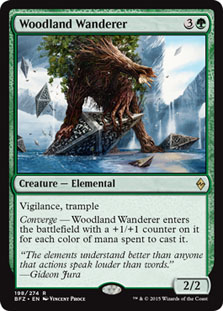
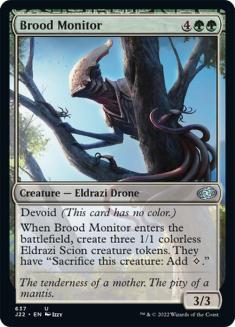
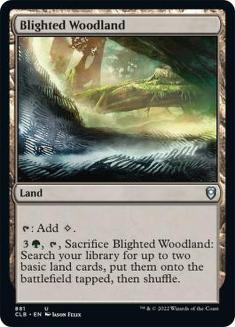
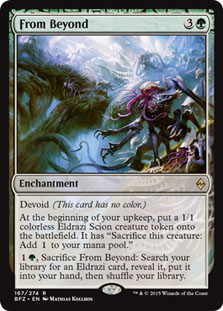

Moving further to fourth through sixth pick, there’s cards that I’ll start picking up if they are there uncontested that imply that a certain set of green
might be open. I’ll take them earlier, but there’s no info extracted from seeing Eyeless Watcher third, where as a fifth pick one is a reason to bias
towards Forests. The last few entries here bleed a bit lower into the sixth through ninth pick range, partly because people don’t like to pick them up
early and they can float through other green drafters a bit too easily. Again, I’m not above taking these cards earlier, but seeing a seventh pick Tajuru
Stalwart means to me that Converge might be a good place to be.
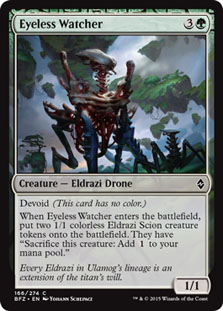
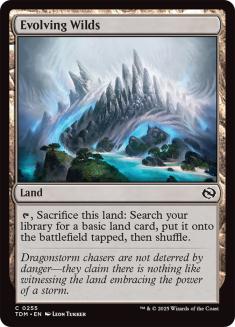
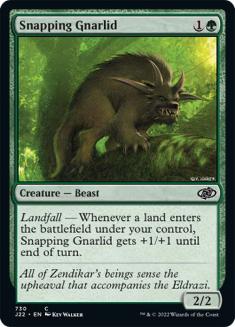
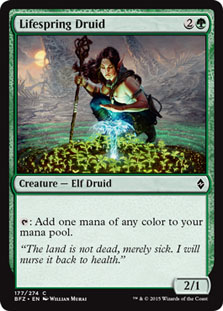
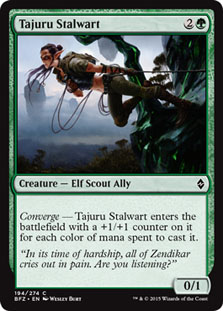
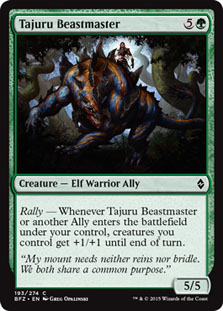

Then there’s the wheel. There’s exactly one super late pick card worth mentioning here.
If you have multiple Fertile Thickets, you can start doing some really stupid things with your mana. At three+ you can start cutting land and playing solid
three-color decks. The card is fine but unexciting most of the time, but in high densities opens up some awesome things. There’s a lot of reward for what
is usually a tenth or so pick here.
What’s the Truth?
I’m not going to sugar coat it. Green is definitely the color in Battle for Zendikar with the least raw power.
But it isn’t unplayable.
The problem with green is partially power level, but it’s more that it’s very punishing for not understanding how to navigate your draft. The three best
green commons (Eyeless Watcher, Snapping Gnarlid, Tajuru Stalwart) aren’t directly good together. Sure, you can use Tajuru Beastmaster to make three-color
Overrun Allies and want to play an Eyeless Watcher, or splash in your landfall deck and have a reasonable Tajuru Stalwart with your Snapping Gnarlids, but
you are working to find secondary overlaps. You can’t just “take the good card” because that definition is super dynamic.
Green is also not obvious in the way some of the other colors are. Oh, ingest and Processors work together, and there are literally single words on the
card that tell me this. Oh, Rally, I want to play a decent number of Allies so I can keep triggering my Firemantle Mage or Resolute Blademaster. With
green, you are looking at specific Allies or indirect overlaps. Oh, I want Cliffside Lookout here as the thing that triggers Tajuru Blademaster, but Kor
Entanglers is just okay. I want to Infuse the Elements for 2-3 in my Landfall deck as Territorial Baloth benefits the most from trample, but my four-color
deck is too interested in using its spells slots on removal.
Given this, it’s really easy to see how teams arrived at the “green is unplayable” conclusion. You have two weeks with a set before a Pro Tour and are
lucky to do twenty drafts since you are jamming Constructed too. Even if you are green in 40% of those, that’s five drafts split between a bunch of
archetypes when it might be hard to see what pieces you were missing. Maybe the right uncommons didn’t come around or weren’t opened. Maybe you passed that
Blighted Woodland for a card that reads more powerful but isn’t secretly Overrun on a land in your deck.
So your green decks aren’t as refined and lose a lot. On top of that, the color is probably a little overdrafted. And the easier solution is “Don’t draft
this” rather than “Try to navigate your way through a very difficult set of decisions on very little practice and get super punished if you mess up.”
Someone starts talking, and this mantra has a viral spread. Soon everyone is playing B/W versus U/R versus U/B versus W/R….
And wondering how that idiot with the green cards is always beating them.


